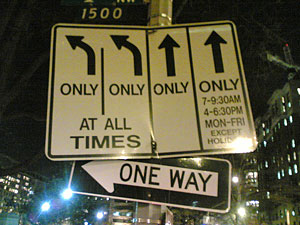Take a look at the traffic signs below. Some are yellow and black. Some are green and white. Some are black and white. One has a round image in it. Several are rectangular. Two are diamond shaped.
They are different in color and different in shape. There are also other important differences in these signs. Can you figure out what they are?

Source: MUTCD R9-3, Wikimedia; MUTCD D5-5, Wikimedia; MUTCD R3-5L, Wikimedia; Japanese Road sign (Right Sharp turn), Monaneko, Wikimedia; MUTCD W14-1, Wikimedia; Speed Limit 55 sign, Ltljltlj, Wikimedia; 2010.05.07_3235, daleexpress, Flickr
The differences have to do with words and visual images. Respond to the questions that follow to discover several differences. Click on one answer for each question.


Source: Street Sign Confusion at 15th and I Streets NW, Wayan Vota, Flickr
Even the colors of the signs are meaningful. Messages can be communicated through visual images, or they can be communicated in words. Many times, messages are communicated using both words and visual images.
Texts, which are more complicated than traffic signs, can certainly use just words. We have books that use just words, and many articles in newspapers and magazines use just words.
In many of these kinds of texts, however, writers who want their texts to “stand out” and be noticed usually include visually interesting elements, anything from different fonts and colors to moving images.
Most long and complex texts are primarily word texts. However, there are long and complex texts that use few or no words at all. How could that be? How could you tell a story with images alone?
You could make a video in which no one speaks.
How could you tell a story in print using only images?
You could make a cartoon strip.
In this lesson, you are going to analyze differences in texts that use visual techniques to present narrative and informational content. You will also look at how information and narration differ when the presentation uses nonvisual texts.